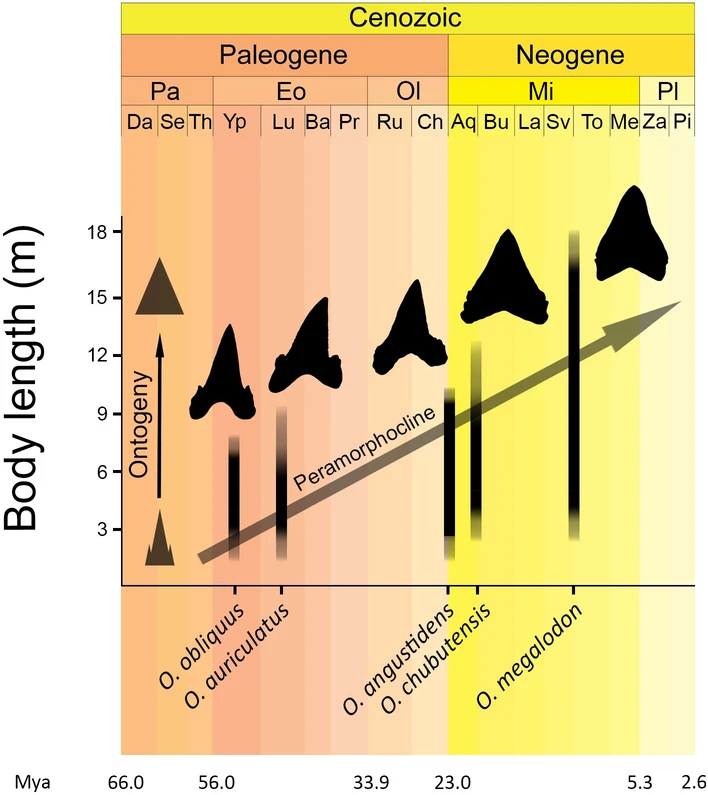|
Lamniformes
The Lamniformes (, from Greek ''lamna'' "fish of prey") are an order (biology), order of sharks commonly known as mackerel sharks (which may also refer specifically to the family Lamnidae). It includes some of the most familiar species of sharks, such as the great white shark, great white as well as less familiar ones, such as the goblin shark and megamouth shark. Members of the order are distinguished by possessing two dorsal fins, an anal fin, five gill, gill slits, eyes without nictitating membranes, and a mouth extending behind the eyes. Species in two families of Lamniformes – Lamnidae and Alopiidae – are distinguished for maintaining a higher body temperature than the surrounding waters. Members of the group include Macro-predator, macropredators, generally of medium-large size, including the largest macropredatory shark ever, the extinct ''Otodus megalodon,'' as well as large planktivores. Although some authors have argued that the Late Jurassic ''Palaeocarcharias'' ... [...More Info...] [...Related Items...] OR: [Wikipedia] [Google] [Baidu] |
Otodus Megalodon
''Otodus megalodon'' ( ; meaning "big tooth"), Common name, commonly known as megalodon, is an extinction, extinct species of giant mackerel shark that lived approximately 23 to 3.6 million years ago (Mya), from the Early Miocene to the Early Pliocene epochs. ''O. megalodon'' was formerly thought to be a member of the family (biology), family Lamnidae and a close relative of the great white shark (''Carcharodon carcharias''), but has been reclassified into the extinct family Otodontidae, which Speciation, diverged from the great white shark during the Early Cretaceous. While regarded as one of the largest and most powerful predators to have ever lived, megalodon is only known from fragmentary remains, and its appearance and maximum size are uncertain. Scientists have argued whether its body form was more stocky or elongated than the modern lamniform sharks. Maximum body length estimates between based on various analyses have been proposed, though the Mode (statistics), modal ... [...More Info...] [...Related Items...] OR: [Wikipedia] [Google] [Baidu] |
Megamouth Shark
The megamouth shark (''Megachasma pelagios'') is a species of deepwater shark. Rarely seen by Human, humans, it measures around long and is the smallest of the three extant taxon, extant filter-feeding sharks alongside the much larger whale shark and basking shark. According to Sharkman's World Organization, a total of 296 specimens have been observed or caught since its discovery in 1976. Like the other two Planktivore, planktivorous sharks, it swims with its mouth wide open, filtering water for plankton and jellyfish. The diet of megamouth sharks mainly consists of zooplanktonic organisms like krill, jellyfish, shrimp Larva, larvae, Squat lobster, squat lobsters, and crab larvae. It is recognizable from its large head with rubbery Lip, lips. The megamouth is so unlike any other type of shark that it is usually considered to be the sole extant species in the family Megachasmidae, though some scientists have suggested it may belong in the family Cetorhinidae. Taxonomy and evol ... [...More Info...] [...Related Items...] OR: [Wikipedia] [Google] [Baidu] |
Palaeocarcharias
''Palaeocarcharias'' is an extinct genus of shark, known from the Jurassic of Europe. It has only a single named species, ''Palaeocarcharias stromeri'', which is known from exceptionally preserved specimens from the Late Jurassic (Tithonian) of Germany ( Solnhofen Limestone) and France ( Canjuers Lagerstatte). Isolated teeth of indeterminate species from England ( White Limestone Formation, and possibly the Forest Marble and Taynton Limestone) extend the range of the genus back to the Middle Jurassic (Bathonian In the geologic timescale the Bathonian is an age (geology), age and stage (stratigraphy), stage of the Middle Jurassic. It lasted from approximately 168.2 ±1.2 annum, Ma to around 165.3 ±1.1 Ma (million years ago). The Bathonian Age succeeds ...). Morphologically, it closely resembles carpet sharks (Orectolobiformes), and is around in total body length. However, it shares greater similarities in tooth development with mackerel sharks (Lamniformes), including the ... [...More Info...] [...Related Items...] OR: [Wikipedia] [Google] [Baidu] |
Shark
Sharks are a group of elasmobranch cartilaginous fish characterized by a ribless endoskeleton, dermal denticles, five to seven gill slits on each side, and pectoral fins that are not fused to the head. Modern sharks are classified within the Division (taxonomy), division Selachii and are the sister group to the Batoidea, Batomorphi (Batoidea, rays and skate (fish), skates). Some sources extend the term "shark" as an informal category including Extinction, extinct members of Chondrichthyes (cartilaginous fish) with a shark-like morphology, such as hybodonts. Shark-like chondrichthyans such as ''Cladoselache'' and ''Doliodus'' first appeared in the Devonian Period (419–359 million years), though some fossilized chondrichthyan-like scales are as old as the Ordovician, Late Ordovician (458–444 million years ago). The earliest confirmed modern sharks (Selachii) are known from the Early Jurassic around , with the oldest known member being ''Agaleus'', though records of true shar ... [...More Info...] [...Related Items...] OR: [Wikipedia] [Google] [Baidu] |
Great White Shark
The great white shark (''Carcharodon carcharias''), also known as the white shark, white pointer, or simply great white, is a species of large Lamniformes, mackerel shark which can be found in the coastal surface waters of all the major oceans. It is the only known surviving species of its genus ''Carcharodon''. The great white shark is notable for its size, with the largest preserved female specimen measuring in length and around in weight at maturity. However, most are smaller; males measure , and females measure on average. According to a 2014 study, the lifespan of great white sharks is estimated to be as long as 70 years or more, well above previous estimates, making it one of the longest lived Chondrichthyes, cartilaginous fishes currently known. According to the same study, male great white sharks take 26 years to reach sexual maturity, while the females take 33 years to be ready to produce offspring. Great white sharks can swim at speeds of 25 km/h (16 mph ... [...More Info...] [...Related Items...] OR: [Wikipedia] [Google] [Baidu] |
Goblin Shark
The goblin shark (''Mitsukurina owstoni'') is a rare species of deep-sea shark. Sometimes called a "living fossil", it is the only extant representative of the family Mitsukurinidae, a lineage some 125 million years old. This pink-skinned animal has a distinctive profile with an elongated, flat snout, and highly protrusible jaws containing prominent nail-like teeth. It is usually between long when mature, though it can grow considerably larger such as one captured in 2000 that is thought to have measured . Goblin sharks are benthopelagic creatures that inhabit upper continental slopes, submarine canyons, and seamounts throughout the world at depths greater than , with adults found deeper than juveniles. Some researchers believed that these sharks could also dive to depths of up to , for short periods of time. However, footage captured in 2024 suggests that their range could be deeper than previously thought, with a confirmed sighting of an adult swimming at . Various anato ... [...More Info...] [...Related Items...] OR: [Wikipedia] [Google] [Baidu] |
Pelagic Thresher
The pelagic thresher (''Alopias pelagicus'') is a species of thresher shark, family Alopiidae; this group of sharks is characterized by the greatly elongated upper lobes of their caudal fins. The pelagic thresher occurs in the tropical and subtropical waters of the Indian and Pacific Oceans, usually far from shore, but occasionally entering coastal habitats. It is often confused with the common thresher (''A. vulpinus''), even in professional publications, but can be distinguished by the dark, rather than white, color over the bases of its pectoral fins. The smallest of the three thresher species, the pelagic thresher typically measures 3 m (10 ft) long. The diet of the pelagic thresher consists mainly of small midwater fishes, which are stunned with whip-like strikes of its tail. Along with all other mackerel sharks, the pelagic thresher exhibits ovoviviparity and usually gives birth to litters of two. The developing embryos are oophagous, feeding on unfertilized e ... [...More Info...] [...Related Items...] OR: [Wikipedia] [Google] [Baidu] |
Bigeye Thresher
The bigeye thresher (''Alopias superciliosus'') is a species of thresher shark, family Thresher shark, Alopiidae, found in temperate and tropical oceans worldwide. Like the other thresher sharks, nearly half its total length consists of the elongated upper lobe of the caudal fin, tail fin. Its common name comes from its enormous eyes, which are placed in keyhole-shaped orbit (anatomy), sockets that allow them to be rotated upward. This species can also be distinguished by a pair of deep grooves on the top of its head, from which its scientific name is derived. The large eyes of the bigeye thresher are adaptation, adapted for hunting in low light conditions. It is one of the few sharks that conduct a diel vertical migration, staying in deep water during the day and moving into surface waters at night to feed. To protect its sensitive brain and eyes from the temperature changes accompanying these movements, the bigeye thresher has a blood vessel, vascular exchange system called the ... [...More Info...] [...Related Items...] OR: [Wikipedia] [Google] [Baidu] |
Thresher Shark
Thresher sharks are large mackerel sharks of the family Alopiidae found in all temperate and tropical oceans of the world; the family contains three extant species, all within the genus ''Alopias''. All three thresher shark species have been listed as vulnerable by the World Conservation Union since 2007 (IUCN). All three are popular big-game sport fish, and additionally they are hunted commercially for their meat, livers (for shark liver oil), skin (for shagreen) and fins (for use in delicacies such as shark-fin soup). Despite being active predatory fish, thresher sharks do not appear to be a threat to humans. Taxonomy The genus and family name derive from the Greek word , , meaning fox. As a result, the long-tailed or common thresher shark, ''Alopias vulpinus'', is also known as the fox shark. The common name is derived from a distinctive, scythe-like tail or caudal fin which can be as long as the body of the shark itself. Species The three extant thresher ... [...More Info...] [...Related Items...] OR: [Wikipedia] [Google] [Baidu] |
Lamnidae
The Lamnidae are the family of mackerel sharks known as white sharks. They are large, fast-swimming predatory fish found in oceans worldwide, though they prefer environments with colder water. The name of the family is formed from the Greek word ''lamna'', which means "fish of prey", and was derived from the Greek legendary creature, the Lamia.: ''A source-book of biological names and terms'', 1944, Edmund Carroll Jaeger These sharks have pointed snouts, spindle-shaped bodies, and large gill openings. The first dorsal fin is large, high, stiff and angular or somewhat rounded. The second dorsal and anal fins are minute. The caudal peduncle has a couple of less distinct keels. The teeth are gigantic. The fifth gill opening is in front of the pectoral fin and spiracles are sometimes absent. They are powerful, heavily built sharks, sometimes weighing nearly twice as much as other sharks of comparable length from other families. Many sharks in the family are among the fastest-swim ... [...More Info...] [...Related Items...] OR: [Wikipedia] [Google] [Baidu] |
California Academy Of Sciences
The California Academy of Sciences is a research institute and natural history museum in San Francisco, San Francisco, California, that is among the largest List of natural history museums, museums of natural history in the world, housing over 46 million specimens. The academy began in 1853 as a learned society and still carries out a large amount of original research. The institution is located in Golden Gate Park on the West Side (San Francisco), West Side of San Francisco. Completely rebuilt in 2008, the academy's primary building in Golden Gate Park covers . In early 2020, before the COVID-19 pandemic, the California Academy of Sciences had around 500 employees and an annual revenue of about $33 million. Governance The California Academy of Sciences, California's oldest operating museum and research institution for the natural sciences, is governed by a 41-member board of trustees who are nominated and chosen by the California Academy of Sciences Fellows. The Academy Fello ... [...More Info...] [...Related Items...] OR: [Wikipedia] [Google] [Baidu] |








